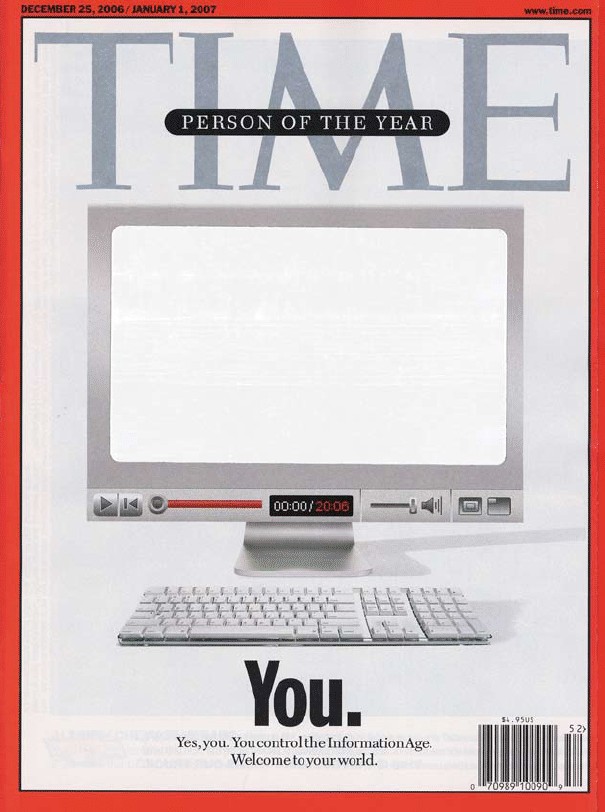- Relief printing
- Intaglio and planographic printing
- Color printing
- Bits and pieces
- Early photography in silver
- Non-silver processes
- Modern photography
- Color notes
- Color photography
- Photography in ink: relief and intaglio printing
- Photography in ink: planographic printing
- Digital processes
- Where do we go from here?
Web Offset

Web photo offset lithography. Arthur Hochstein (designer) and Spencer Jones-Glasshouse (photographer). Cover of Time magazine, December 25, 2006/January 1, 2007. 10 7/16 x 7 7/8" (26.5 x 20 cm). The Museum of Modern Art, New York. Gift of Richard Benson. Courtesy the Editors of Time Magazine © Time, Inc. This cover, printed by web offset, has an aluminized plastic mirror stuck on in the monitor area, intended to reflect the reader’s face.
All the offset printing we have looked at so far was done on cut sheets of paper. The printing speeds gradually increased, from about 4,000 impressions an hour in the early presses up to 10,000 or more for the newest ones. If a book is to have 192 pages, and each press sheet holds sixteen pages (eight per side), then twelve sides must be printed. Even with long makeready times such a book can be done in less than a week as long as the edition is no more than a few thousand. When we get to magazines routinely printed in editions of hundreds of thousands, with a new issue weekly or monthly the math simply doesn’t work out. There has to be a faster way to print. The answer is web printing. For readers under thirty I must emphasize that this is not the World Wide Web we are talking about, but paper printed on rolls instead of sheets.
Web printing was first developed for letterpress newspaper work, where time was a central concern, and it gradually moved over to offset. When a press prints individual sheets, its speed is limited by the need to properly register each sheet moving into it. This cannot be done without stopping the sheet at some point, moving it against register guides, and then accelerating it up to the press speed. But it turns out that there is no speed limit for the actual printing itself; plate, blanket, and paper are quite happy moving ink around at far higher speeds than any sheet-fed press can manage. If the printing is done on a roll of paper, and with a workable, high-speed registration system, there is in principle no limit to how fast a press can print. That high-speed registration system turned out to be a stroboscopic light, which reads register marks printed on the paper and adjusts the tension of the web to keep things aligned. Web presses are so fast that heat drying is used so the paper can be cut and folded right in the press, which discharges full signatures at the other end. In order to get finished pages the press must print both sides of the roll; this is called “perfecting,” and the web press must have eight printing units instead of the four that a sheet-fed press needs for color work. A large web press may be 200 feet long, with the four or five printing units occupying perhaps a third of its length and the feeder, dryer, and folder taking up the rest. Web presses return profits when run continuously, and they even have devices built into them allowing the input rolls of paper to be changed without stopping them. A good web press can print 35,000 to 50,000 impressions per hour, on sixteen magazine pages at a time, with four-color pictures, using halftones of 200 dots per linear inch, printing on both sides of the web. The operators have to wear ear protection, and when things go wrong they do so really quickly, but it is web printing that makes all those magazines, newspapers, and catalogs possible.

